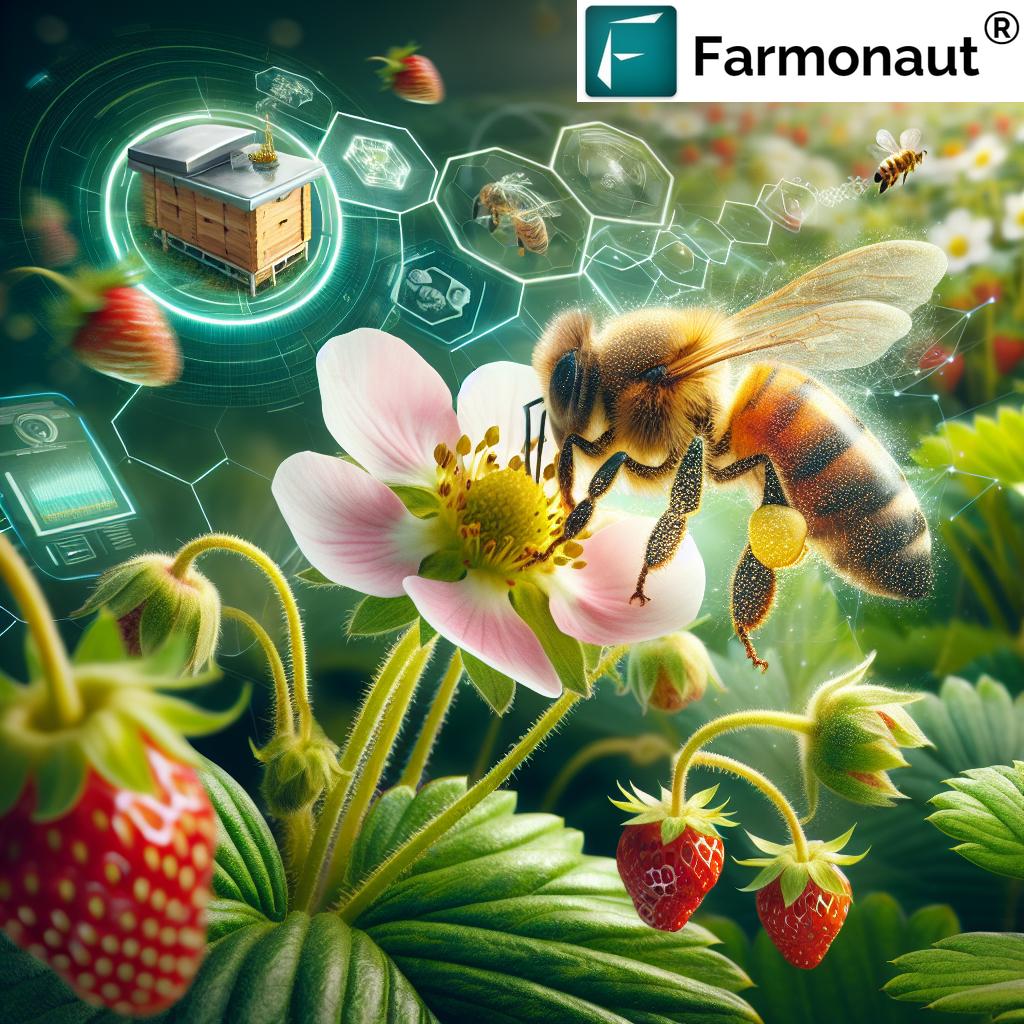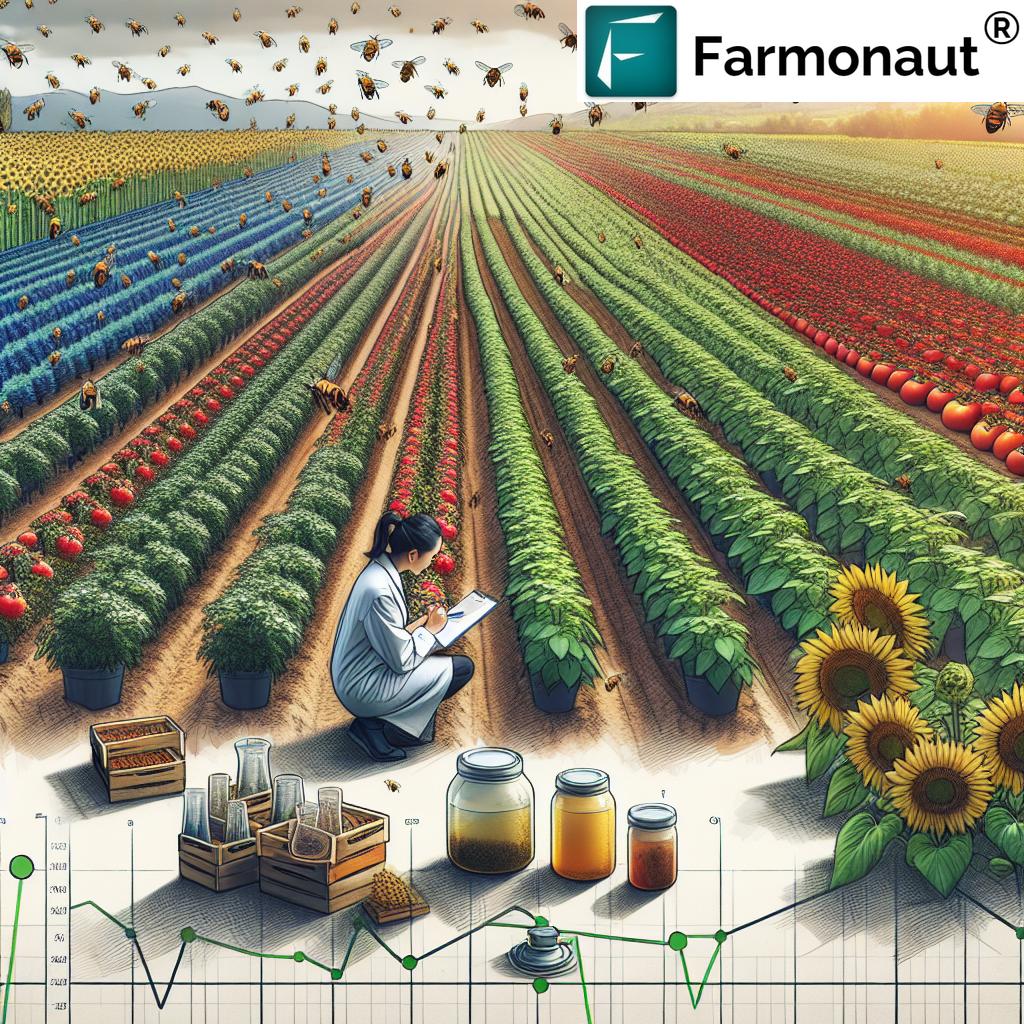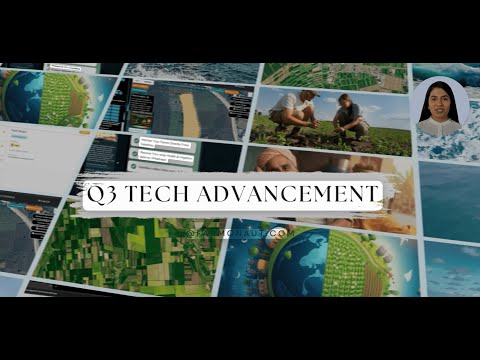Revolutionizing Agriculture: How Bee Vectoring Technology is Transforming Sustainable Pest Management for Crops
“Bee vectoring technology can increase crop yields by up to 29% through combined pollination and biopesticide delivery.”
In the ever-evolving world of agriculture, we at Farmonaut are excited to explore groundbreaking innovations that promise to reshape the future of farming. Today, we’re diving into one such revolutionary technique: bee vectoring technology. This ingenious approach to sustainable pest management is not only transforming how we protect our crops but also harnessing the natural power of bees to enhance pollination and boost yields.

Understanding Bee Vectoring Technology
Bee vectoring technology is an innovative farming technique that leverages the natural behaviors of bees to deliver biological crop protection agents directly to flowering plants. This method combines the essential service of pollination with eco-friendly disease control, offering a dual benefit to farmers and the environment alike.
At its core, bee vectoring technology utilizes both honey bees and bumble bees to carry and distribute a safe, EPA-approved biopesticide known as CR7. As these industrious insects go about their daily pollination activities, they simultaneously deliver this protective agent to crops, creating a targeted and efficient pest management system.
The Science Behind Bee Vectoring
The scientific principles underlying bee vectoring are both fascinating and elegant in their simplicity. Here’s how it works:
- Biopesticide Formulation: The CR7 biopesticide is formulated into a powder that can easily adhere to the bodies of bees.
- Hive Integration: Special dispensers containing the biopesticide powder are integrated into the bee hives.
- Natural Distribution: As bees exit their hives, they pass through these dispensers, picking up the powder on their bodies.
- Targeted Delivery: During their pollination flights, bees distribute the biopesticide directly to the flowers of crops.
- Continuous Protection: This process repeats with each bee flight, ensuring consistent and targeted crop protection throughout the flowering period.
This method’s brilliance lies in its ability to harness the bees’ natural behaviors, turning them into efficient, eco-friendly vectors for crop protection.
Benefits of Bee Vectoring Technology
The advantages of this innovative approach to pest management are numerous and far-reaching:
- Increased Crop Yields: Studies have shown that bee vectoring can increase crop yields by up to 29%, thanks to the combined benefits of enhanced pollination and disease control.
- Reduced Chemical Use: By delivering biopesticides directly to flowers, this method significantly reduces the need for broad-spectrum chemical pesticides.
- Targeted Application: The bees deliver the biopesticide precisely where it’s needed most – the flowers – minimizing waste and environmental impact.
- Water Conservation: Unlike traditional spraying methods, bee vectoring doesn’t require water for application, contributing to water conservation efforts.
- Pollinator Health: By using safe, biological crop protection agents, this method supports the health of both managed and wild pollinator populations.
These benefits align perfectly with the growing demand for sustainable agricultural practices and the need to protect our vital pollinator species.
Crops Benefiting from Bee Vectoring
Bee vectoring technology has shown remarkable efficacy across a wide range of crops, including:
- Berries: Strawberries, blueberries, and caneberries have all shown significant improvements in yield and disease resistance.
- Sunflowers: These pollinator-dependent crops benefit greatly from the dual action of pollination and pest control.
- Apples: Orchards using bee vectoring have reported reduced incidence of fungal diseases and improved fruit quality.
- Tomatoes: Greenhouse tomato production has seen notable benefits, particularly in disease management.
- Canola: This important oilseed crop shows enhanced pollination and reduced pest pressure with bee vectoring.
The versatility of this technology makes it a promising solution for a wide array of agricultural sectors.
“The EPA-approved biopesticide CR7 is delivered by both honey bees and bumble bees in this innovative pest management system.”
The Role of CR7 Biopesticide
At the heart of this bee vectoring system is the CR7 biopesticide. This biological agent is derived from a naturally occurring fungus, Clonostachys rosea, which has been extensively studied for its beneficial properties in crop protection.
CR7 works by:
- Colonizing plant tissues to prevent harmful fungi from establishing
- Stimulating the plant’s natural defense mechanisms
- Promoting overall plant health and resilience
The use of CR7 exemplifies the shift towards more sustainable, biological approaches to crop protection, moving away from synthetic chemical pesticides.

Comparison: Bee Vectoring vs. Traditional Pest Management
| Aspect | Bee Vectoring Technology | Traditional Pest Management | Environmental Impact |
|---|---|---|---|
| Application Method | Targeted delivery by bees | Broad spraying or soil application | Bee vectoring has minimal off-target impact |
| Pesticide Usage | Minimal, biological agents only | Often high, including synthetic chemicals | Bee vectoring significantly reduces chemical load in environment |
| Pollination Benefits | Enhanced pollination services | No additional pollination benefit | Bee vectoring supports pollinator populations |
| Crop Yield Increase | Up to 29% increase reported | Variable, often lower | Higher yields with less environmental impact |
| Sustainability | Highly sustainable, supports ecosystem | Often less sustainable, potential ecosystem disruption | Bee vectoring aligns with sustainable agriculture goals |
| Cost-Effectiveness | Initially higher setup, long-term savings | Lower initial costs, ongoing expenses | Bee vectoring offers long-term environmental and economic benefits |
This comparison clearly illustrates the numerous advantages of bee vectoring technology over traditional pest management methods, particularly in terms of environmental impact and long-term sustainability.
Implementation and Best Practices
Implementing bee vectoring technology requires careful planning and adherence to best practices:
- Hive Placement: Strategic positioning of bee hives to ensure optimal coverage of the crop area.
- Timing: Synchronizing the introduction of bees with the crop’s flowering period for maximum effectiveness.
- Monitoring: Regular observation of bee activity and crop health to assess the system’s efficacy.
- Integration: Combining bee vectoring with other sustainable farming practices for a holistic approach to crop management.
- Training: Educating farm workers on the importance of protecting bees and maintaining the vectoring system.
By following these guidelines, farmers can maximize the benefits of bee vectoring technology while supporting pollinator health and ecosystem balance.
The Future of Bee Vectoring Technology
As we look to the future, the potential for bee vectoring technology is immense. Ongoing research and development in this field are focusing on:
- Expanding the range of crops that can benefit from this technology
- Developing new biopesticides and beneficial microorganisms for vectoring
- Improving hive designs and dispenser systems for even more efficient delivery
- Integrating bee vectoring with precision agriculture technologies for optimized farm management
The continuous advancement of bee vectoring technology promises to play a crucial role in shaping the future of sustainable agriculture.
Farmonaut’s Perspective on Innovative Agricultural Technologies
At Farmonaut, we’re committed to advancing sustainable agricultural practices through innovative technologies. While we don’t directly produce bee vectoring technologies, our satellite-based farm management solutions complement such innovative approaches by providing valuable insights for optimal implementation.
Our platform offers:
- Real-time crop health monitoring to assess the effectiveness of pest management strategies
- AI-driven advisory systems that can help farmers integrate bee vectoring with other sustainable practices
- Resource management tools to optimize the use of biological control agents
By combining cutting-edge technologies like bee vectoring with Farmonaut’s precision agriculture solutions, farmers can take a holistic approach to sustainable crop management.
Explore Farmonaut’s innovative agricultural solutions:
For developers interested in integrating our satellite and weather data:
Download our mobile apps for on-the-go farm management:
Environmental and Economic Impact
The adoption of bee vectoring technology has far-reaching implications for both the environment and the economy:
Environmental Benefits
- Reduced Chemical Runoff: By minimizing the use of traditional pesticides, bee vectoring helps protect water sources from chemical contamination.
- Biodiversity Support: The use of biological control agents promotes a healthier ecosystem, supporting diverse flora and fauna.
- Pollinator Conservation: This technology actively supports bee populations, crucial for maintaining biodiversity and food security.
- Lower Carbon Footprint: Reduced need for mechanical spraying operations leads to lower fuel consumption and emissions.
Economic Advantages
- Increased Crop Yields: The dual benefit of enhanced pollination and pest control can significantly boost farm productivity and revenue.
- Reduced Input Costs: Over time, the decreased reliance on chemical pesticides can lead to substantial savings for farmers.
- Premium Market Access: Crops grown using eco-friendly methods like bee vectoring may command higher prices in certain markets.
- Long-term Sustainability: By preserving soil health and supporting ecosystem balance, this technology helps ensure the long-term viability of agricultural operations.
These impacts underscore the potential of bee vectoring technology to contribute to more sustainable and profitable agricultural systems worldwide.
Challenges and Considerations
While bee vectoring technology offers numerous benefits, it’s important to consider some challenges and areas for further development:
- Initial Setup Costs: The initial investment in hives, bees, and vectoring equipment can be significant for some farmers.
- Weather Dependence: Bee activity is influenced by weather conditions, which can affect the consistency of biopesticide delivery.
- Crop Specificity: Not all crops are equally suitable for bee vectoring, limiting its application in some agricultural sectors.
- Education and Training: Farmers and agricultural workers need proper training to effectively implement and manage bee vectoring systems.
- Regulatory Considerations: As a relatively new technology, bee vectoring may face varying regulatory landscapes in different regions.
Addressing these challenges will be crucial for the wider adoption and success of bee vectoring technology in global agriculture.
The Role of Technology in Modern Agriculture
The integration of bee vectoring technology into modern farming practices exemplifies the broader trend of technological innovation in agriculture. This trend aligns closely with Farmonaut’s mission to make precision agriculture more accessible and affordable for farmers worldwide.
Key technological advancements shaping the future of agriculture include:
- Satellite-Based Crop Monitoring: Technologies like those offered by Farmonaut provide real-time insights into crop health and growth patterns.
- Artificial Intelligence and Machine Learning: These technologies are revolutionizing farm management, offering predictive analytics and personalized recommendations.
- IoT and Sensor Technology: Connected devices and sensors enable precise monitoring of soil conditions, weather, and crop health.
- Blockchain for Traceability: Ensuring transparency and authenticity in agricultural supply chains.
- Drone Technology: Offering new possibilities for crop monitoring, mapping, and even targeted interventions.
By embracing these technologies alongside innovative approaches like bee vectoring, farmers can create more resilient, productive, and sustainable agricultural systems.
Conclusion: A Sustainable Future for Agriculture
Bee vectoring technology represents a significant leap forward in our quest for sustainable agricultural practices. By harnessing the natural behaviors of bees to deliver targeted crop protection, this innovative approach offers a harmonious solution that benefits crops, farmers, and the environment alike.
As we at Farmonaut continue to develop and promote cutting-edge agricultural technologies, we see bee vectoring as a complementary innovation that aligns perfectly with our vision of a more sustainable and efficient farming future. The combination of precision agriculture tools, like those we offer, with eco-friendly pest management solutions like bee vectoring, paves the way for a new era in agriculture – one that prioritizes environmental stewardship without compromising on productivity.
The journey towards sustainable agriculture is ongoing, and technologies like bee vectoring play a crucial role in this evolution. As we move forward, the integration of such innovative approaches with data-driven farming practices will be key to addressing global food security challenges while preserving our planet’s precious ecosystems.
We encourage farmers, researchers, and agricultural professionals to explore the potential of bee vectoring technology and to consider how it might be integrated with other sustainable farming practices. Together, we can cultivate a future where agriculture not only feeds the world but also nurtures and protects our environment for generations to come.
FAQ Section
Q1: What is bee vectoring technology?
A1: Bee vectoring technology is an innovative farming technique that uses bees to deliver biological crop protection agents directly to flowering plants, combining pollination with eco-friendly pest control.
Q2: How does bee vectoring work?
A2: Bees pick up a specially formulated biopesticide powder as they exit their hives and distribute it to flowers during their natural pollination activities, providing targeted crop protection.
Q3: What types of crops can benefit from bee vectoring?
A3: Bee vectoring has shown success with various crops, including strawberries, blueberries, sunflowers, apples, tomatoes, and canola, among others.
Q4: Is bee vectoring technology safe for bees?
A4: Yes, the biopesticides used in bee vectoring are specifically designed to be safe for bees and other pollinators, promoting overall bee health and ecosystem balance.
Q5: How does bee vectoring compare to traditional pesticide application?
A5: Bee vectoring offers more targeted application, reduced chemical use, enhanced pollination, and potentially higher crop yields compared to traditional pesticide spraying methods.







